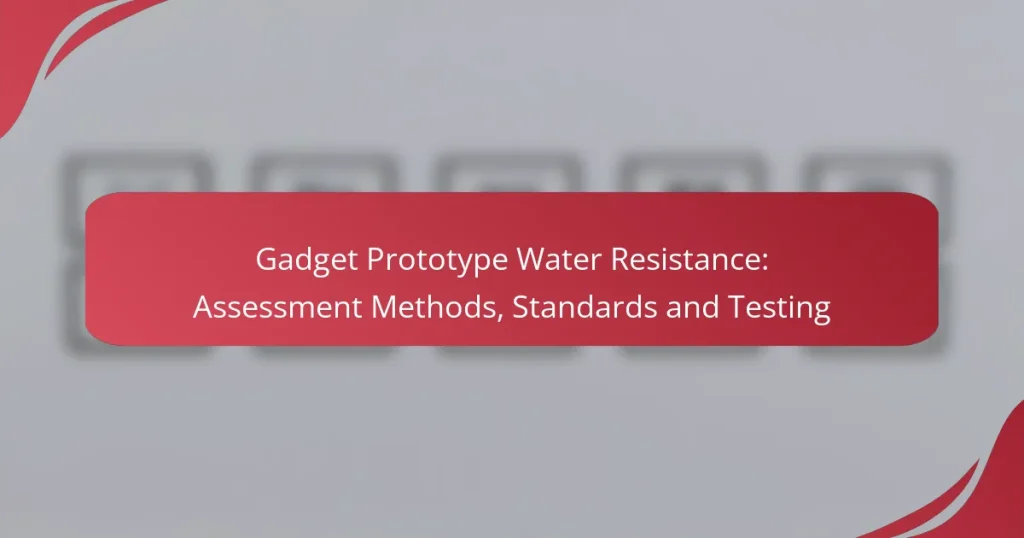Assessing water resistance in gadget prototypes is crucial for ensuring their durability and functionality in real-world conditions. This process involves various methods such as visual inspections, pressure testing, and submersion tests, all of which provide insights into a device’s ability to withstand water exposure. Adhering to industry standards during testing helps manufacturers meet consumer expectations for performance in wet environments.
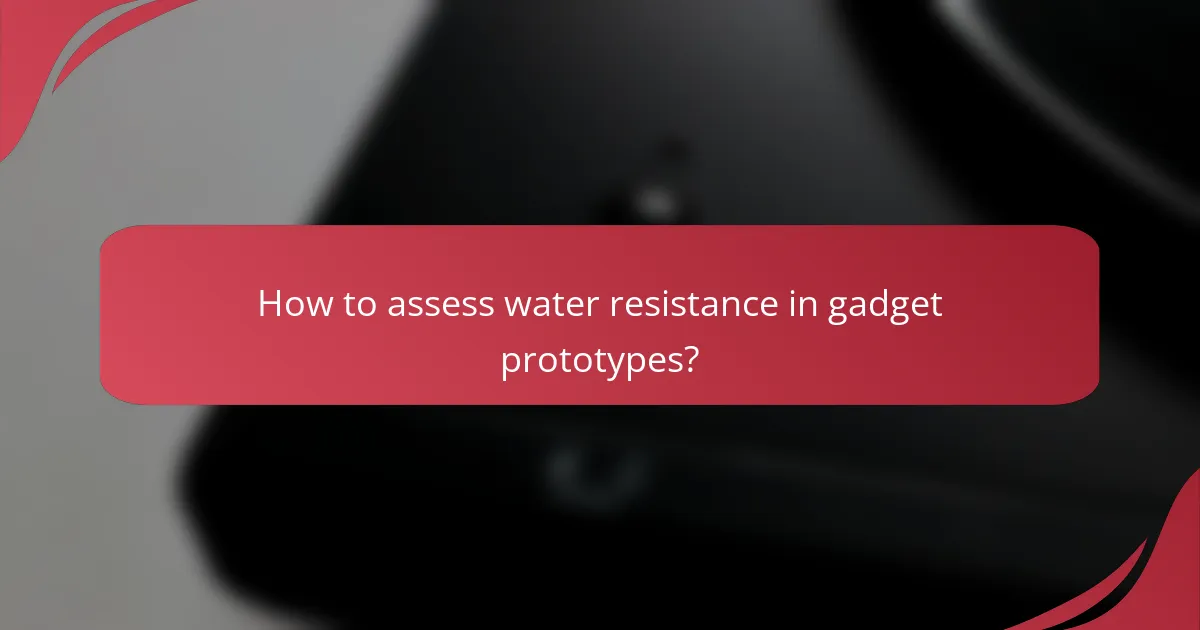
How to assess water resistance in gadget prototypes?
Assessing water resistance in gadget prototypes involves a combination of visual inspections, pressure testing, submersion tests, and environmental chamber evaluations. Each method provides valuable insights into how well a device can withstand exposure to water, helping to ensure durability and functionality in real-world conditions.
Visual inspection methods
Visual inspection methods are the first step in assessing water resistance. This involves checking for any visible defects, such as cracks, gaps, or poorly sealed joints that could allow water ingress. Regularly examining prototypes during development can help identify potential issues early.
Look for signs of wear or damage around ports, buttons, and seams. Using a magnifying glass or microscope can enhance the inspection process, ensuring that even small flaws are detected.
Pressure testing techniques
Pressure testing techniques evaluate how a gadget prototype performs under varying water pressure conditions. This method simulates real-world scenarios where devices may be submerged or exposed to water jets. Testing can be done using a pressure chamber that gradually increases pressure to assess the prototype’s integrity.
Common standards for pressure testing include IP (Ingress Protection) ratings, which classify devices based on their resistance to water and dust. For example, an IP67 rating indicates that a device can withstand immersion in water up to 1 meter for 30 minutes.
Submersion tests
Submersion tests involve fully immersing the gadget prototype in water for a specified duration to determine its water resistance. This method helps identify any leaks or failures that may occur when the device is submerged. Typically, tests last from a few minutes to several hours, depending on the intended use of the gadget.
It’s crucial to monitor the device during the test and check for any signs of moisture intrusion afterward. Using colored water can help visualize leaks more effectively.
Environmental chamber evaluations
Environmental chamber evaluations simulate various environmental conditions, including humidity and temperature, to assess how these factors affect water resistance. This method allows for controlled testing that can replicate extreme conditions, such as heavy rain or high humidity environments.
During these evaluations, gadgets are subjected to cycles of moisture and temperature changes to see how well they maintain their water resistance over time. This testing is particularly important for devices intended for outdoor use or in humid climates.
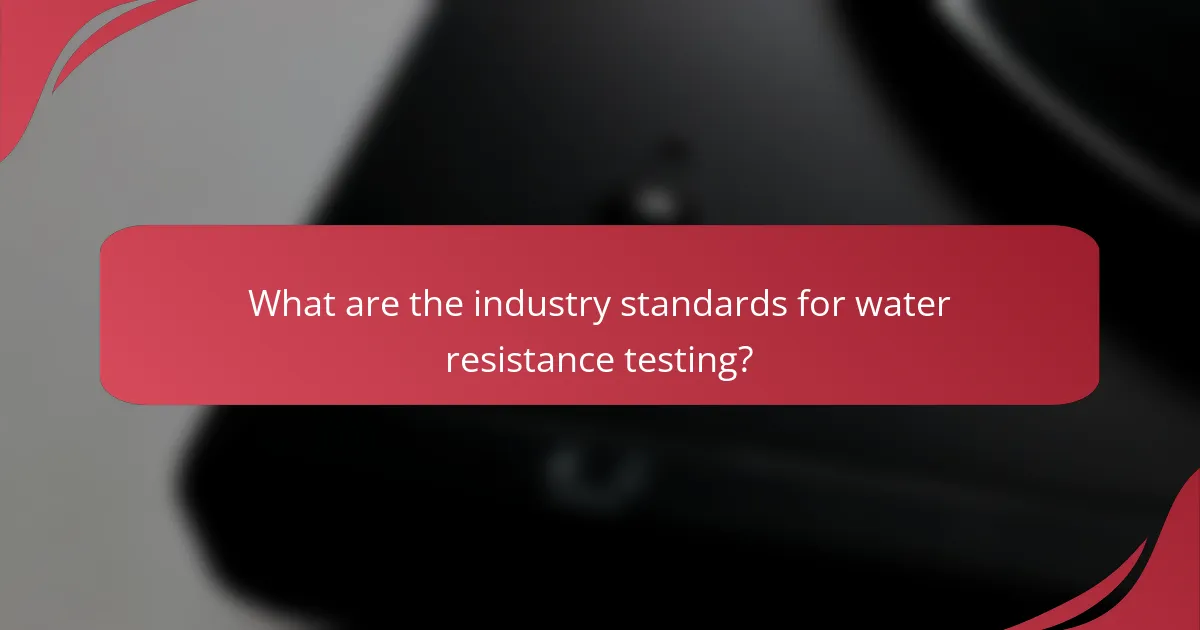
What are the industry standards for water resistance testing?
Industry standards for water resistance testing define how devices can be evaluated for their ability to withstand exposure to water. These standards help manufacturers ensure that their products meet consumer expectations for durability and performance in wet conditions.
IP ratings explained
IP ratings, or Ingress Protection ratings, indicate the level of protection a device has against dust and water. The rating consists of two digits; the first digit represents solid particle protection, while the second digit indicates liquid ingress protection. For example, an IP67 rating means the device is dust-tight and can withstand immersion in water up to 1 meter for 30 minutes.
Common IP ratings include IP54, which offers limited dust protection and splash resistance, and IP68, which provides complete dust protection and can handle continuous immersion in water beyond 1 meter. Understanding these ratings helps consumers choose devices suitable for their specific needs.
IEC 60529 standard overview
The IEC 60529 standard outlines the criteria for determining the IP ratings of electronic devices. This standard specifies the testing methods for assessing both dust and water resistance, ensuring consistency across different manufacturers. Devices are subjected to various tests, such as exposure to water jets or immersion in water, to evaluate their performance.
Manufacturers must adhere to this standard to claim specific IP ratings, which helps consumers make informed decisions. Compliance with IEC 60529 is crucial for products intended for use in environments where water exposure is likely.
ASTM F1249 standard details
ASTM F1249 is a standard that focuses on the water vapor transmission rate (WVTR) of materials, particularly in packaging and electronics. This standard measures how much moisture can pass through a material over time, which is essential for assessing long-term water resistance. Understanding WVTR helps manufacturers select appropriate materials for devices that may be exposed to humid conditions.
While ASTM F1249 is not directly about water immersion, it provides valuable insights into how materials behave in moisture-laden environments. This information can guide the design of water-resistant gadgets, ensuring they maintain functionality and integrity over time.

What are the best practices for water resistance testing?
Best practices for water resistance testing involve thorough preparation, accurate calibration of equipment, and meticulous documentation of results. These steps ensure reliable assessments that meet industry standards and provide clear insights into a gadget’s durability against water exposure.
Pre-testing preparation steps
Before conducting water resistance tests, ensure that the prototype is clean and free from any contaminants that could affect results. Inspect the device for any visible damage or defects that might compromise its water resistance capabilities.
Additionally, familiarize yourself with the specific testing standards relevant to your product, such as IP ratings or ASTM guidelines. This knowledge will guide the testing process and help set appropriate expectations for performance.
Calibration of testing equipment
Accurate calibration of testing equipment is crucial for reliable water resistance assessments. Use calibrated instruments that are regularly maintained to ensure precision in measurements, such as pressure gauges and water immersion tanks.
Check the manufacturer’s specifications for the equipment to determine the correct calibration procedures. This may involve adjusting settings based on environmental conditions, such as temperature and humidity, which can influence test outcomes.
Documenting test results
Documenting test results systematically is essential for evaluating water resistance performance and for future reference. Record all relevant data, including test conditions, equipment settings, and any anomalies observed during testing.
Utilize a standardized format for documentation to facilitate easy comparison across different tests. This can include tables that summarize results, highlighting key metrics such as the duration of exposure and any signs of water ingress.
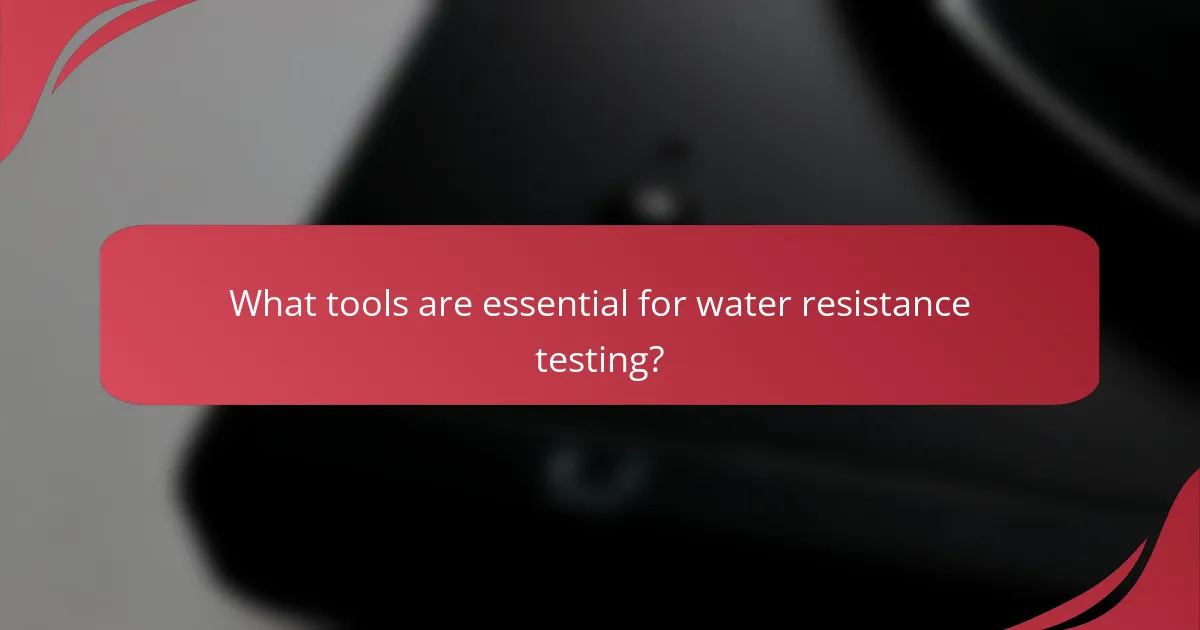
What tools are essential for water resistance testing?
Essential tools for water resistance testing include waterproof testing chambers, pressure gauges, and data logging software. These instruments help assess how well a gadget can withstand exposure to water under various conditions.
Waterproof testing chambers
Waterproof testing chambers simulate different water exposure scenarios to evaluate a gadget’s resistance. These chambers can create conditions such as immersion, spray, or rain, allowing for comprehensive assessments based on specific standards like IP ratings.
When selecting a testing chamber, consider its size, the ability to control water temperature, and the range of pressure it can simulate. For example, chambers that can handle pressures from 1 to 10 bar are suitable for most consumer electronics.
Pressure gauges
Pressure gauges measure the water pressure exerted on a device during testing, which is crucial for determining its water resistance. Accurate pressure readings help ensure that tests align with industry standards and provide reliable results.
Look for gauges that offer high precision and a range suitable for your testing needs, typically between 0 to 15 bar for consumer gadgets. Regular calibration of these gauges is essential to maintain accuracy and reliability in testing outcomes.
Data logging software
Data logging software records and analyzes the results of water resistance tests, providing insights into performance over time. This software can track parameters such as pressure, temperature, and duration of exposure, which are vital for thorough evaluations.
Choose software that integrates easily with your testing equipment and offers features like real-time monitoring and detailed reporting. This can help identify trends and potential weaknesses in a gadget’s design, leading to improvements before market release.

How to choose the right testing method for your gadget?
Selecting the appropriate testing method for your gadget’s water resistance involves understanding the specific requirements of your prototype and the intended use environment. Factors such as the level of water exposure, material properties, and budget constraints will guide your decision-making process.
Factors influencing method selection
The choice of testing method is influenced by several factors, including the expected water exposure level and the gadget’s intended use. For example, if the device is meant for outdoor use in wet conditions, a more rigorous testing method like IP rating assessments may be necessary.
Additionally, the complexity of the gadget can dictate the testing approach. Simple devices may only require basic splash resistance tests, while more sophisticated gadgets might need comprehensive submersion tests to ensure durability.
Cost considerations
Cost is a critical factor when selecting a testing method. Basic water resistance tests can range from a few hundred to a few thousand USD, depending on the complexity and the laboratory conducting the tests. More advanced methods, such as those involving environmental chambers, can significantly increase costs.
It’s essential to balance the cost with the level of assurance required. For prototypes in early development stages, consider using less expensive methods to identify major issues before investing in more comprehensive testing.
Prototype material compatibility
The materials used in your gadget prototype can significantly affect the choice of testing method. Certain materials may react differently to water exposure, influencing their performance and durability. For instance, plastics may require different testing protocols compared to metals or composites.
Understanding the compatibility of your materials with various testing methods is crucial. Always consult material specifications and previous testing results to ensure that the chosen method accurately reflects the prototype’s water resistance capabilities.
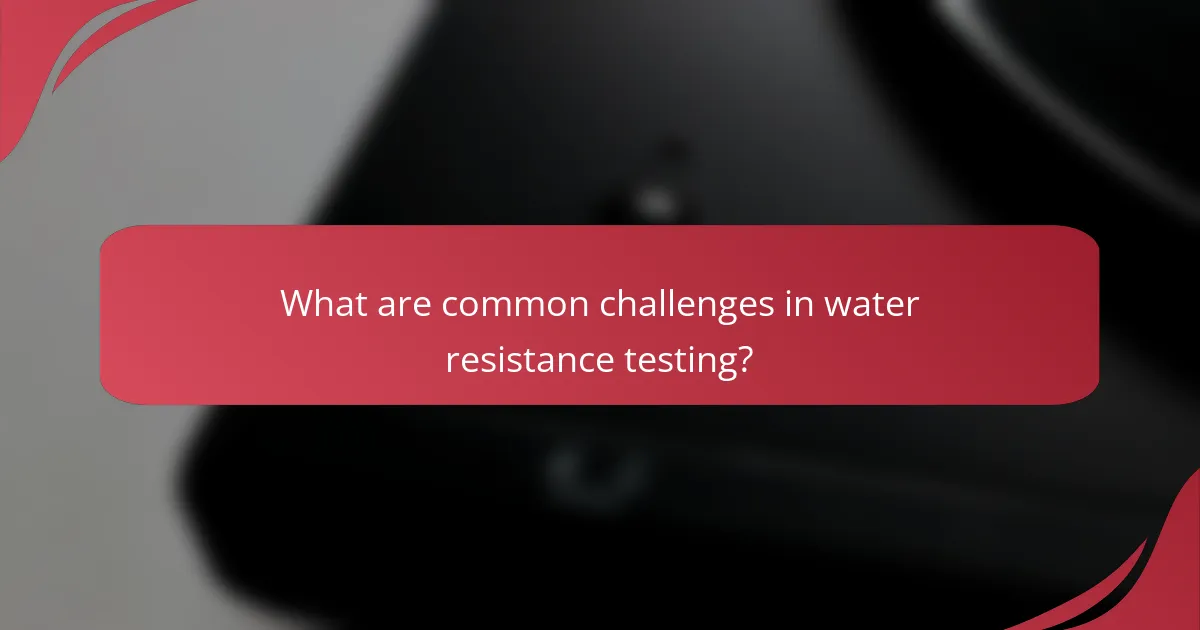
What are common challenges in water resistance testing?
Water resistance testing faces several challenges, including variability in testing conditions, the complexity of design features, and the need for standardized methods. Ensuring consistent results can be difficult due to differences in environmental factors and product specifications.
Variability in Testing Conditions
Testing water resistance often involves various environmental factors such as temperature, pressure, and water type. These conditions can significantly affect the results, leading to discrepancies in performance assessment. For instance, testing in freshwater versus saltwater may yield different outcomes, complicating the evaluation process.
Complexity of Design Features
Modern gadgets often incorporate intricate designs and materials that can influence their water resistance. Features like seams, buttons, and ports may create vulnerabilities that are not easily tested. Manufacturers must consider how these elements interact with water exposure during testing to ensure accurate assessments.
Need for Standardized Methods
The lack of universally accepted testing standards can lead to inconsistent results across different products and manufacturers. While some guidelines exist, such as IP ratings, not all products are tested under the same conditions. Adopting standardized methods is crucial for reliable comparisons and consumer confidence.
